Networking: OSI, DOD, TCP/IP Models and Connection Types
VerifiedAdded on 2021/06/18
|9
|2031
|373
Report
AI Summary
This report provides a comprehensive overview of networking, addressing key aspects crucial for establishing a new business plan, particularly concerning LAN installation. The paper delves into the interoperability of different equipment, emphasizing the importance of network models such as OSI, DOD, and TCP/IP for seamless connectivity. It explores various connection types, including twisted pair cables, coaxial cables, fiber optics, and wireless networks, evaluating their advantages and disadvantages. The report also discusses transmission speeds, specifically focusing on synchronous connections and calculating the required transmission speed for a given data packet size and transmission time. The conclusion highlights the significance of adhering to connection standards, utilizing optimal technologies like wireless networks and fiber optics, and following OSI standards for device interoperability. The report advocates for a strategic mix of fiber optics and wireless networks to achieve high-speed, cost-effective, and secure networking solutions, along with the importance of synchronous connections for efficient data transmission.

Running head: NETWORKING
Networking
Name of the Student
Name of the University
Author note
Networking
Name of the Student
Name of the University
Author note
Paraphrase This Document
Need a fresh take? Get an instant paraphrase of this document with our AI Paraphraser
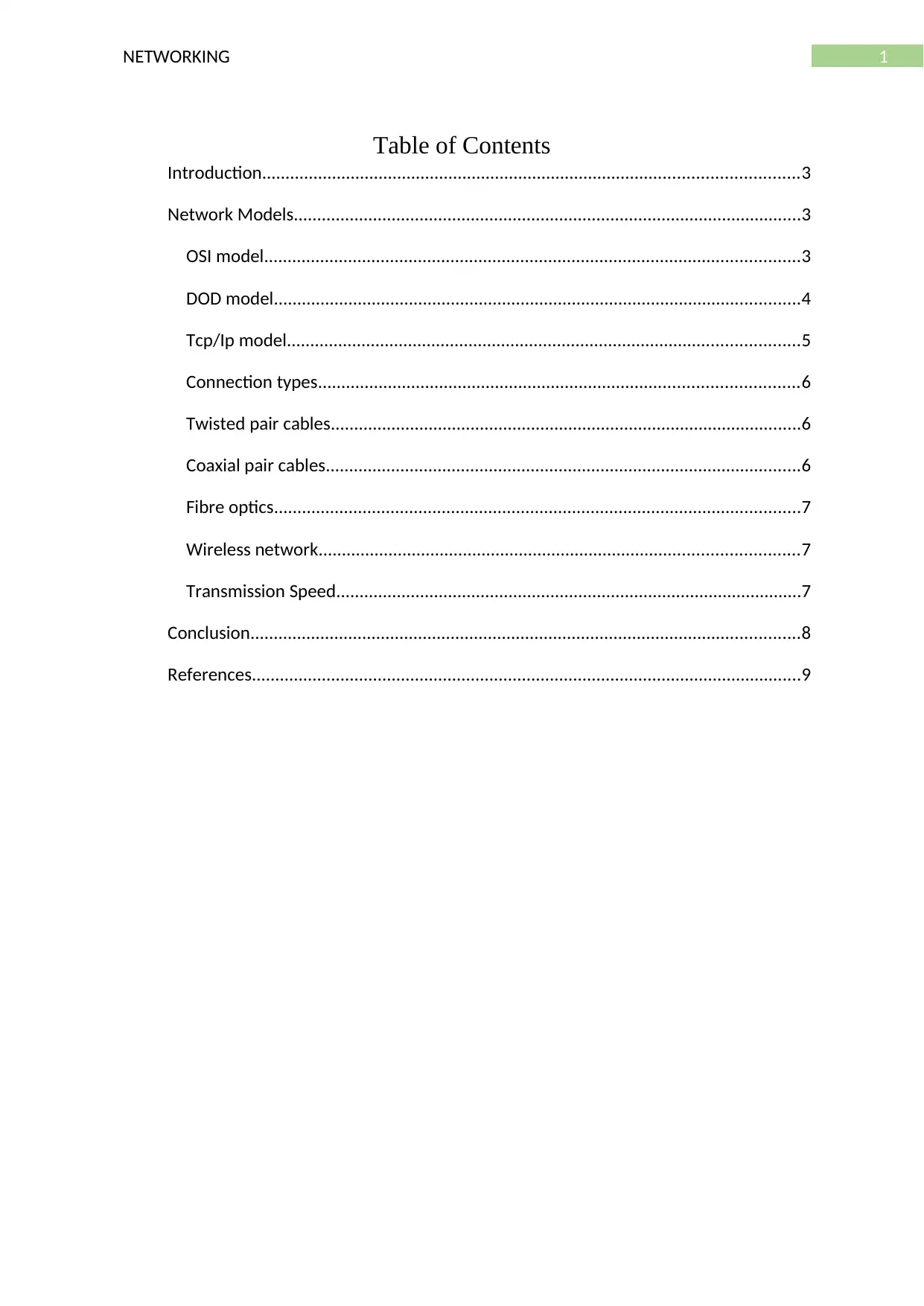
1NETWORKING
Table of Contents
Introduction...................................................................................................................3
Network Models.............................................................................................................3
OSI model...................................................................................................................3
DOD model.................................................................................................................4
Tcp/Ip model..............................................................................................................5
Connection types.......................................................................................................6
Twisted pair cables.....................................................................................................6
Coaxial pair cables......................................................................................................6
Fibre optics.................................................................................................................7
Wireless network.......................................................................................................7
Transmission Speed....................................................................................................7
Conclusion......................................................................................................................8
References......................................................................................................................9
Table of Contents
Introduction...................................................................................................................3
Network Models.............................................................................................................3
OSI model...................................................................................................................3
DOD model.................................................................................................................4
Tcp/Ip model..............................................................................................................5
Connection types.......................................................................................................6
Twisted pair cables.....................................................................................................6
Coaxial pair cables......................................................................................................6
Fibre optics.................................................................................................................7
Wireless network.......................................................................................................7
Transmission Speed....................................................................................................7
Conclusion......................................................................................................................8
References......................................................................................................................9
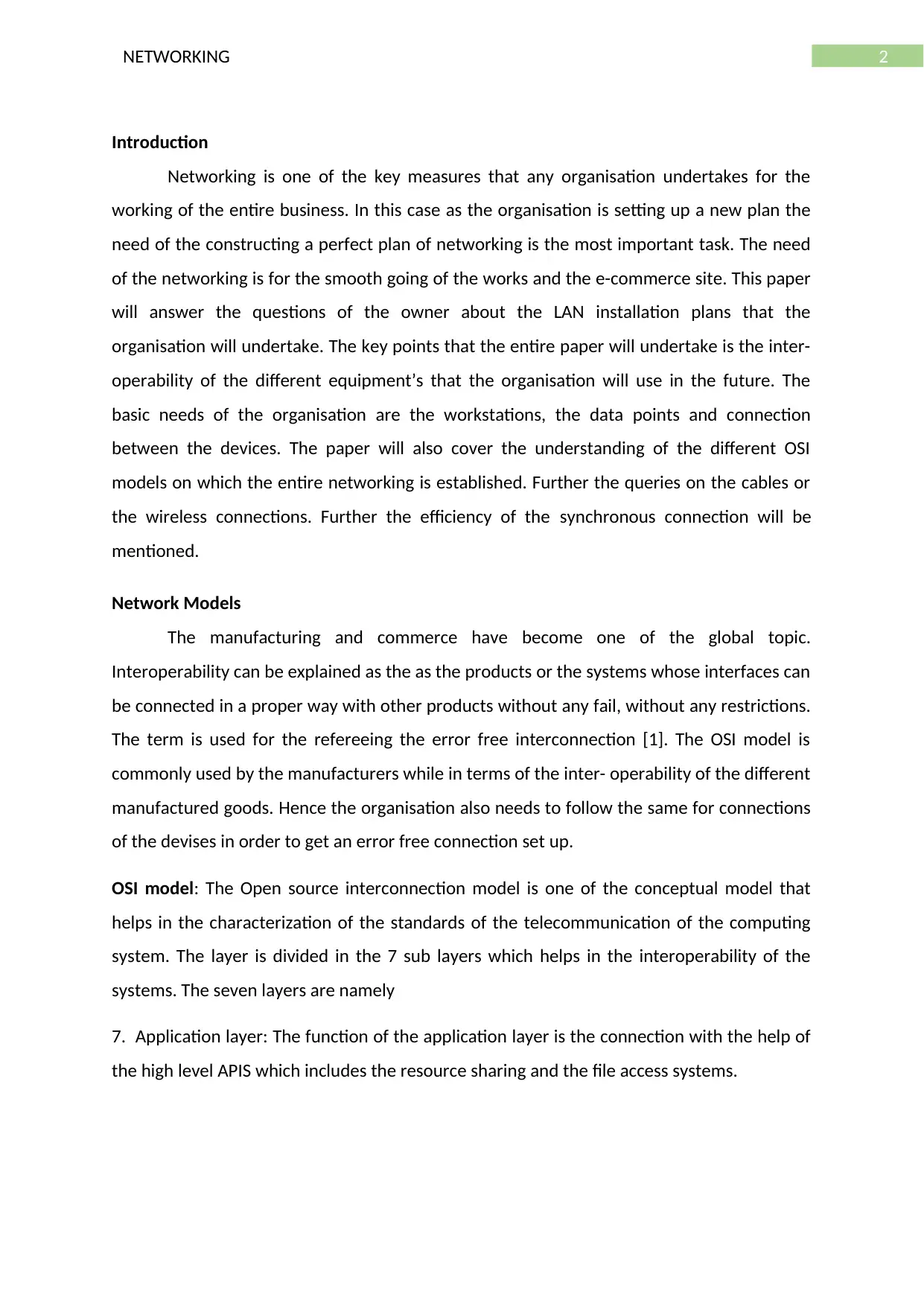
2NETWORKING
Introduction
Networking is one of the key measures that any organisation undertakes for the
working of the entire business. In this case as the organisation is setting up a new plan the
need of the constructing a perfect plan of networking is the most important task. The need
of the networking is for the smooth going of the works and the e-commerce site. This paper
will answer the questions of the owner about the LAN installation plans that the
organisation will undertake. The key points that the entire paper will undertake is the inter-
operability of the different equipment’s that the organisation will use in the future. The
basic needs of the organisation are the workstations, the data points and connection
between the devices. The paper will also cover the understanding of the different OSI
models on which the entire networking is established. Further the queries on the cables or
the wireless connections. Further the efficiency of the synchronous connection will be
mentioned.
Network Models
The manufacturing and commerce have become one of the global topic.
Interoperability can be explained as the as the products or the systems whose interfaces can
be connected in a proper way with other products without any fail, without any restrictions.
The term is used for the refereeing the error free interconnection [1]. The OSI model is
commonly used by the manufacturers while in terms of the inter- operability of the different
manufactured goods. Hence the organisation also needs to follow the same for connections
of the devises in order to get an error free connection set up.
OSI model: The Open source interconnection model is one of the conceptual model that
helps in the characterization of the standards of the telecommunication of the computing
system. The layer is divided in the 7 sub layers which helps in the interoperability of the
systems. The seven layers are namely
7. Application layer: The function of the application layer is the connection with the help of
the high level APIS which includes the resource sharing and the file access systems.
Introduction
Networking is one of the key measures that any organisation undertakes for the
working of the entire business. In this case as the organisation is setting up a new plan the
need of the constructing a perfect plan of networking is the most important task. The need
of the networking is for the smooth going of the works and the e-commerce site. This paper
will answer the questions of the owner about the LAN installation plans that the
organisation will undertake. The key points that the entire paper will undertake is the inter-
operability of the different equipment’s that the organisation will use in the future. The
basic needs of the organisation are the workstations, the data points and connection
between the devices. The paper will also cover the understanding of the different OSI
models on which the entire networking is established. Further the queries on the cables or
the wireless connections. Further the efficiency of the synchronous connection will be
mentioned.
Network Models
The manufacturing and commerce have become one of the global topic.
Interoperability can be explained as the as the products or the systems whose interfaces can
be connected in a proper way with other products without any fail, without any restrictions.
The term is used for the refereeing the error free interconnection [1]. The OSI model is
commonly used by the manufacturers while in terms of the inter- operability of the different
manufactured goods. Hence the organisation also needs to follow the same for connections
of the devises in order to get an error free connection set up.
OSI model: The Open source interconnection model is one of the conceptual model that
helps in the characterization of the standards of the telecommunication of the computing
system. The layer is divided in the 7 sub layers which helps in the interoperability of the
systems. The seven layers are namely
7. Application layer: The function of the application layer is the connection with the help of
the high level APIS which includes the resource sharing and the file access systems.
⊘ This is a preview!⊘
Do you want full access?
Subscribe today to unlock all pages.

Trusted by 1+ million students worldwide
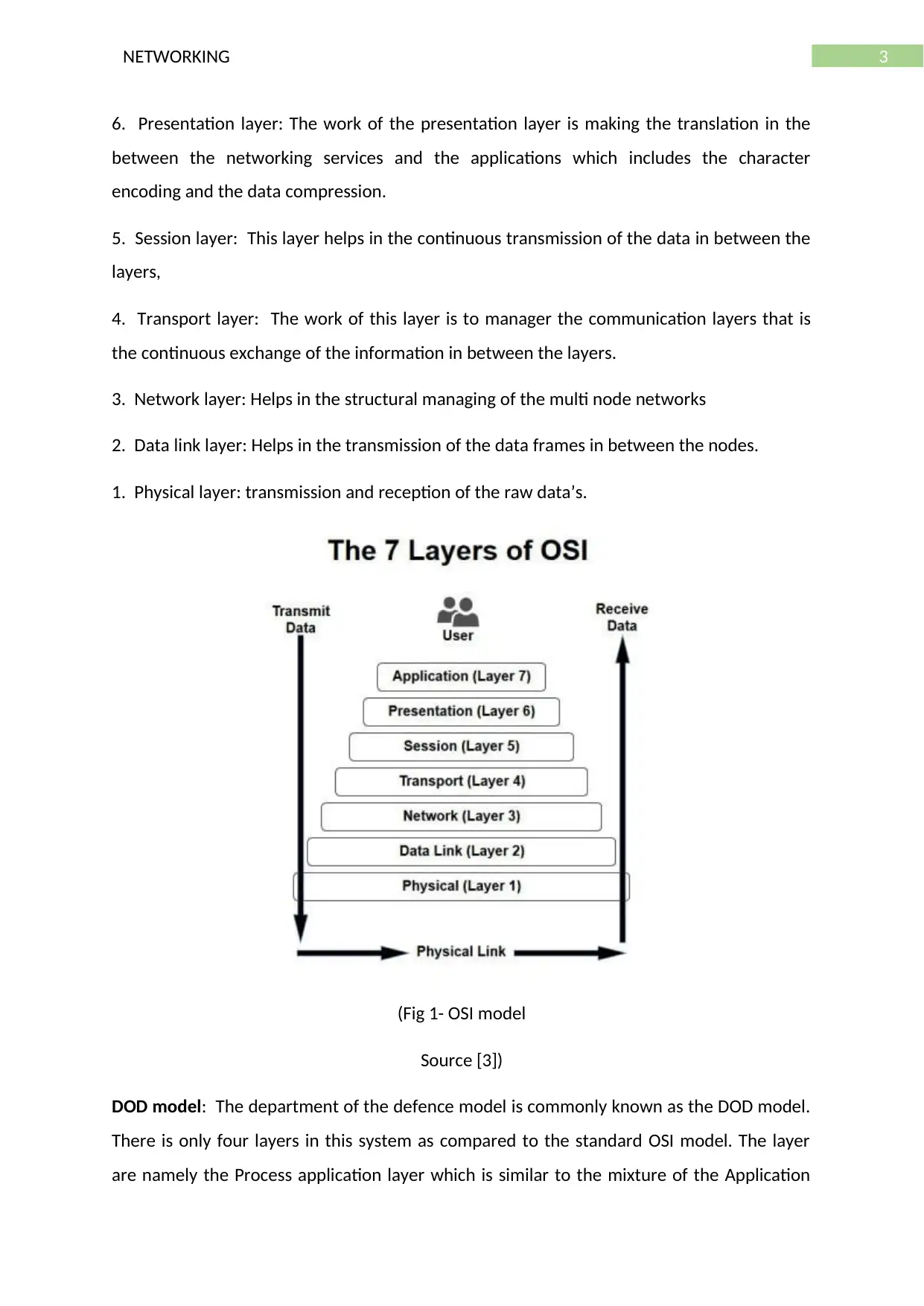
3NETWORKING
6. Presentation layer: The work of the presentation layer is making the translation in the
between the networking services and the applications which includes the character
encoding and the data compression.
5. Session layer: This layer helps in the continuous transmission of the data in between the
layers,
4. Transport layer: The work of this layer is to manager the communication layers that is
the continuous exchange of the information in between the layers.
3. Network layer: Helps in the structural managing of the multi node networks
2. Data link layer: Helps in the transmission of the data frames in between the nodes.
1. Physical layer: transmission and reception of the raw data’s.
(Fig 1- OSI model
Source [3])
DOD model: The department of the defence model is commonly known as the DOD model.
There is only four layers in this system as compared to the standard OSI model. The layer
are namely the Process application layer which is similar to the mixture of the Application
6. Presentation layer: The work of the presentation layer is making the translation in the
between the networking services and the applications which includes the character
encoding and the data compression.
5. Session layer: This layer helps in the continuous transmission of the data in between the
layers,
4. Transport layer: The work of this layer is to manager the communication layers that is
the continuous exchange of the information in between the layers.
3. Network layer: Helps in the structural managing of the multi node networks
2. Data link layer: Helps in the transmission of the data frames in between the nodes.
1. Physical layer: transmission and reception of the raw data’s.
(Fig 1- OSI model
Source [3])
DOD model: The department of the defence model is commonly known as the DOD model.
There is only four layers in this system as compared to the standard OSI model. The layer
are namely the Process application layer which is similar to the mixture of the Application
Paraphrase This Document
Need a fresh take? Get an instant paraphrase of this document with our AI Paraphraser
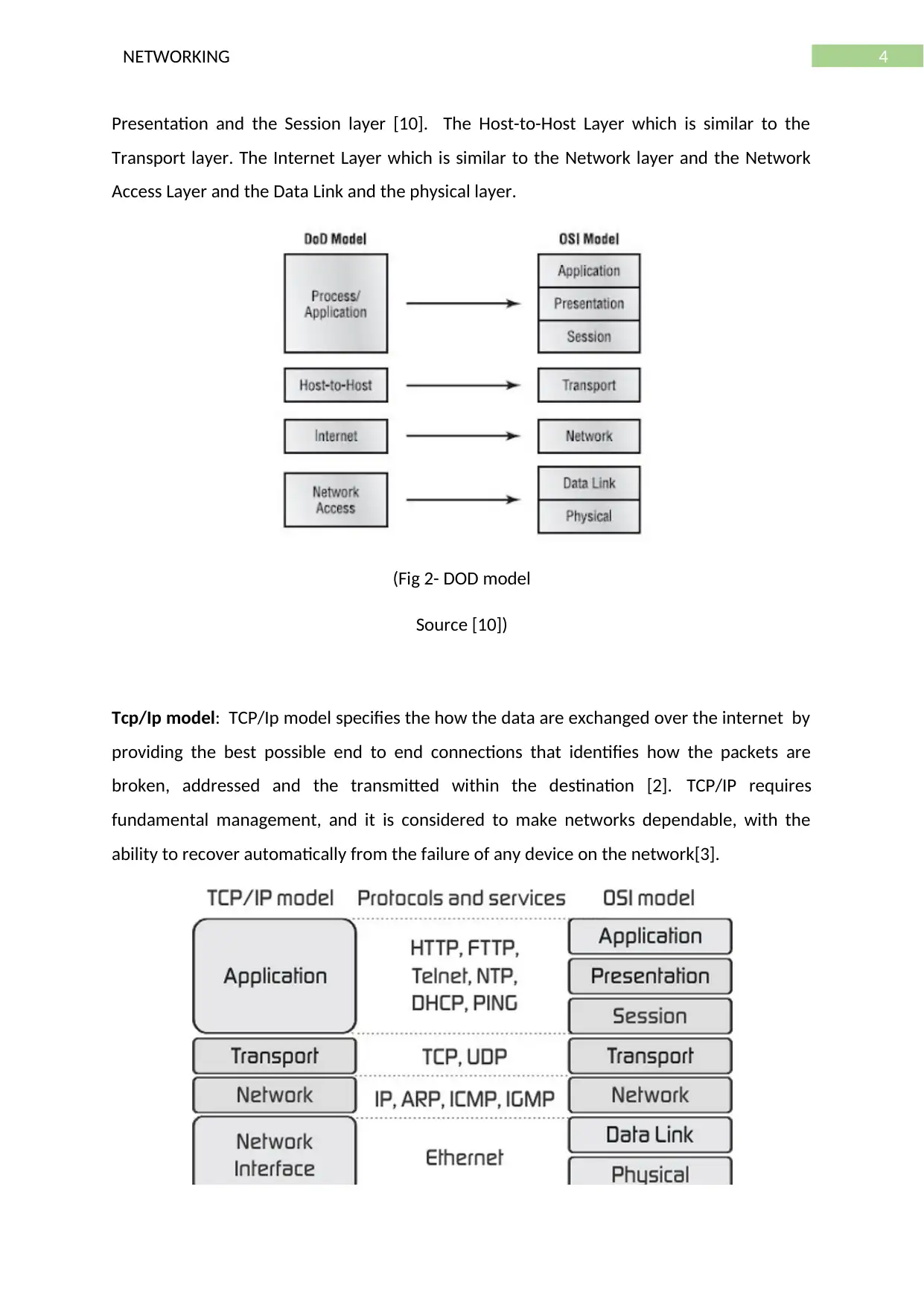
4NETWORKING
Presentation and the Session layer [10]. The Host-to-Host Layer which is similar to the
Transport layer. The Internet Layer which is similar to the Network layer and the Network
Access Layer and the Data Link and the physical layer.
(Fig 2- DOD model
Source [10])
Tcp/Ip model: TCP/Ip model specifies the how the data are exchanged over the internet by
providing the best possible end to end connections that identifies how the packets are
broken, addressed and the transmitted within the destination [2]. TCP/IP requires
fundamental management, and it is considered to make networks dependable, with the
ability to recover automatically from the failure of any device on the network[3].
Presentation and the Session layer [10]. The Host-to-Host Layer which is similar to the
Transport layer. The Internet Layer which is similar to the Network layer and the Network
Access Layer and the Data Link and the physical layer.
(Fig 2- DOD model
Source [10])
Tcp/Ip model: TCP/Ip model specifies the how the data are exchanged over the internet by
providing the best possible end to end connections that identifies how the packets are
broken, addressed and the transmitted within the destination [2]. TCP/IP requires
fundamental management, and it is considered to make networks dependable, with the
ability to recover automatically from the failure of any device on the network[3].
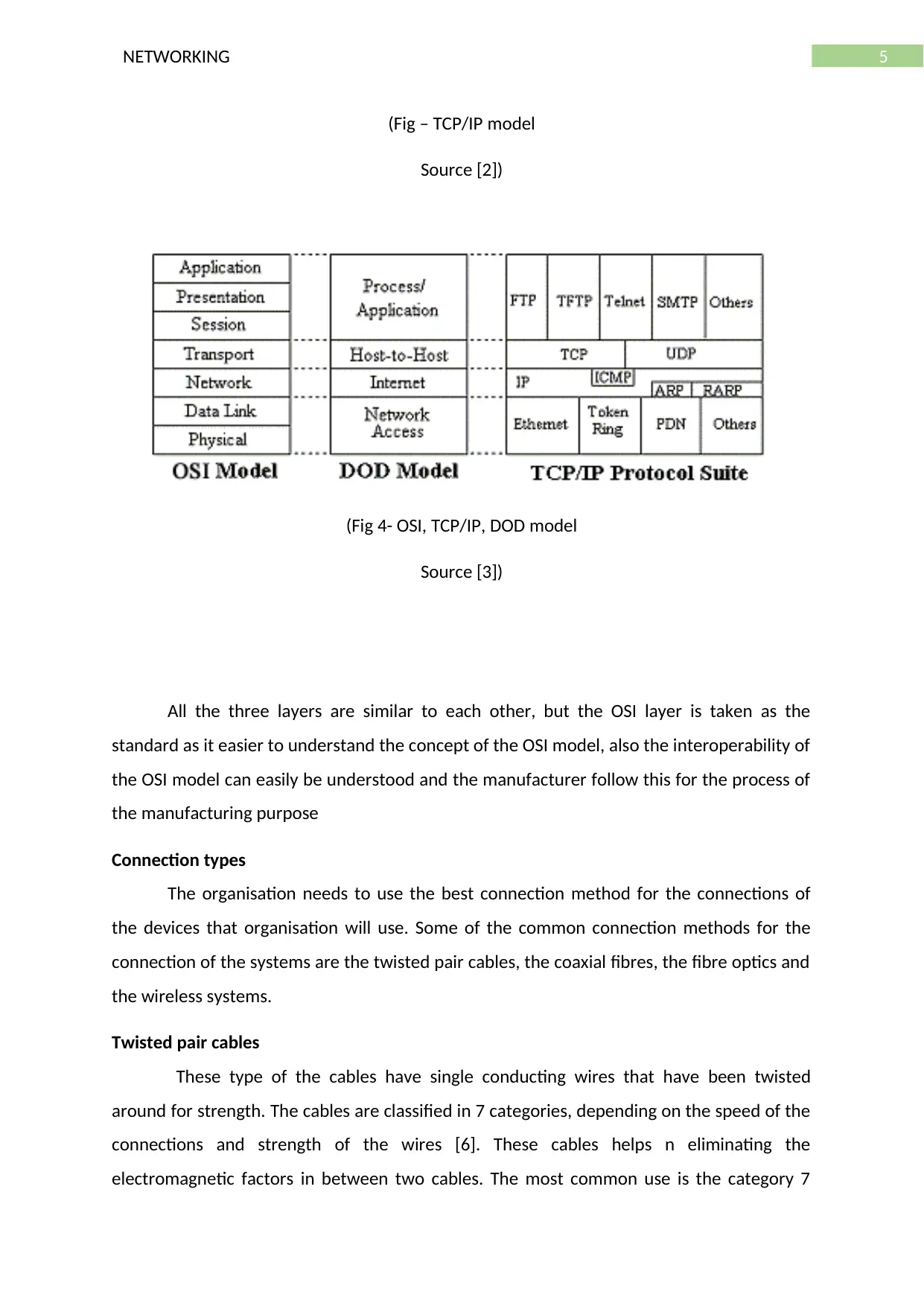
5NETWORKING
(Fig – TCP/IP model
Source [2])
(Fig 4- OSI, TCP/IP, DOD model
Source [3])
All the three layers are similar to each other, but the OSI layer is taken as the
standard as it easier to understand the concept of the OSI model, also the interoperability of
the OSI model can easily be understood and the manufacturer follow this for the process of
the manufacturing purpose
Connection types
The organisation needs to use the best connection method for the connections of
the devices that organisation will use. Some of the common connection methods for the
connection of the systems are the twisted pair cables, the coaxial fibres, the fibre optics and
the wireless systems.
Twisted pair cables
These type of the cables have single conducting wires that have been twisted
around for strength. The cables are classified in 7 categories, depending on the speed of the
connections and strength of the wires [6]. These cables helps n eliminating the
electromagnetic factors in between two cables. The most common use is the category 7
(Fig – TCP/IP model
Source [2])
(Fig 4- OSI, TCP/IP, DOD model
Source [3])
All the three layers are similar to each other, but the OSI layer is taken as the
standard as it easier to understand the concept of the OSI model, also the interoperability of
the OSI model can easily be understood and the manufacturer follow this for the process of
the manufacturing purpose
Connection types
The organisation needs to use the best connection method for the connections of
the devices that organisation will use. Some of the common connection methods for the
connection of the systems are the twisted pair cables, the coaxial fibres, the fibre optics and
the wireless systems.
Twisted pair cables
These type of the cables have single conducting wires that have been twisted
around for strength. The cables are classified in 7 categories, depending on the speed of the
connections and strength of the wires [6]. These cables helps n eliminating the
electromagnetic factors in between two cables. The most common use is the category 7
⊘ This is a preview!⊘
Do you want full access?
Subscribe today to unlock all pages.

Trusted by 1+ million students worldwide
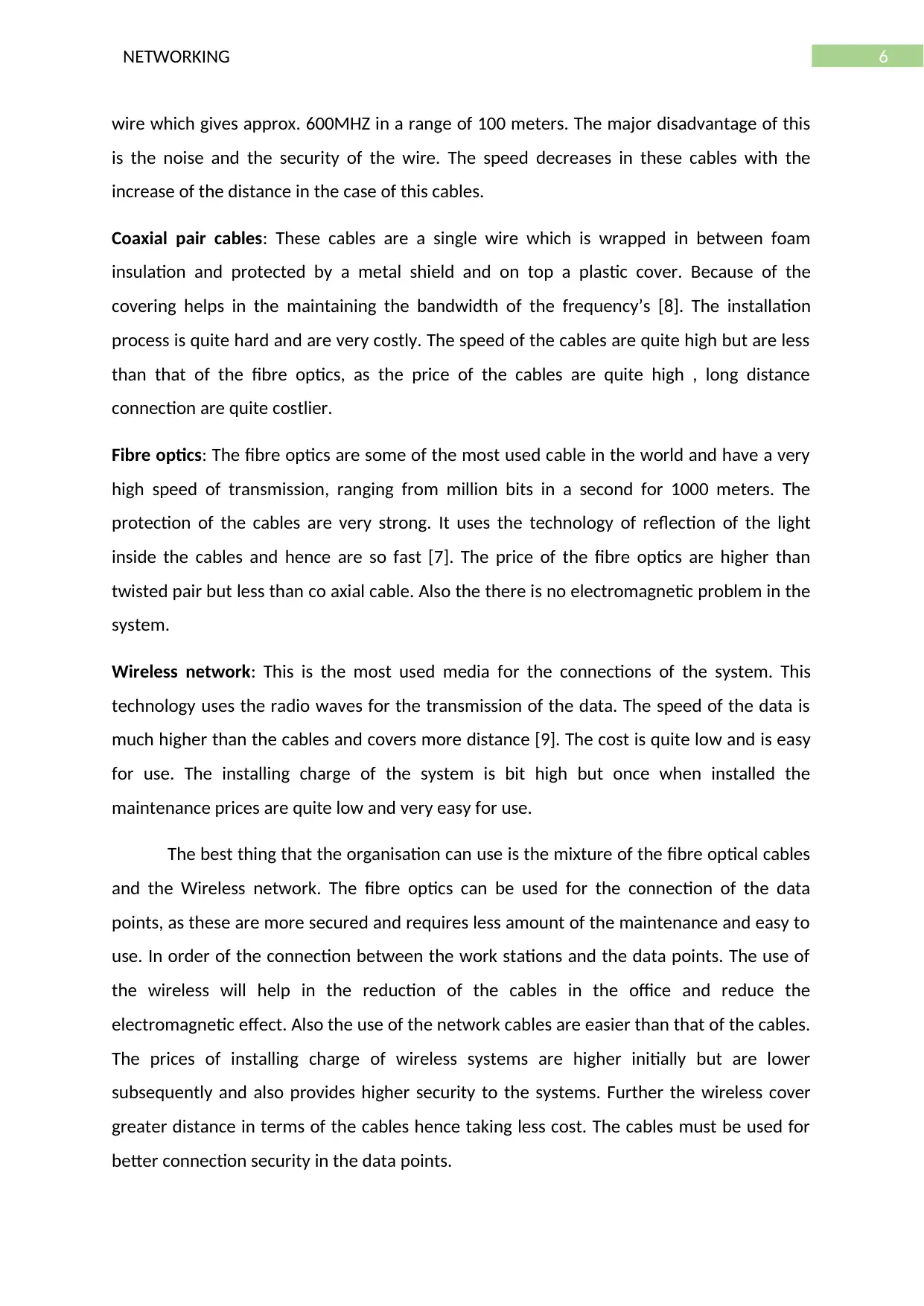
6NETWORKING
wire which gives approx. 600MHZ in a range of 100 meters. The major disadvantage of this
is the noise and the security of the wire. The speed decreases in these cables with the
increase of the distance in the case of this cables.
Coaxial pair cables: These cables are a single wire which is wrapped in between foam
insulation and protected by a metal shield and on top a plastic cover. Because of the
covering helps in the maintaining the bandwidth of the frequency’s [8]. The installation
process is quite hard and are very costly. The speed of the cables are quite high but are less
than that of the fibre optics, as the price of the cables are quite high , long distance
connection are quite costlier.
Fibre optics: The fibre optics are some of the most used cable in the world and have a very
high speed of transmission, ranging from million bits in a second for 1000 meters. The
protection of the cables are very strong. It uses the technology of reflection of the light
inside the cables and hence are so fast [7]. The price of the fibre optics are higher than
twisted pair but less than co axial cable. Also the there is no electromagnetic problem in the
system.
Wireless network: This is the most used media for the connections of the system. This
technology uses the radio waves for the transmission of the data. The speed of the data is
much higher than the cables and covers more distance [9]. The cost is quite low and is easy
for use. The installing charge of the system is bit high but once when installed the
maintenance prices are quite low and very easy for use.
The best thing that the organisation can use is the mixture of the fibre optical cables
and the Wireless network. The fibre optics can be used for the connection of the data
points, as these are more secured and requires less amount of the maintenance and easy to
use. In order of the connection between the work stations and the data points. The use of
the wireless will help in the reduction of the cables in the office and reduce the
electromagnetic effect. Also the use of the network cables are easier than that of the cables.
The prices of installing charge of wireless systems are higher initially but are lower
subsequently and also provides higher security to the systems. Further the wireless cover
greater distance in terms of the cables hence taking less cost. The cables must be used for
better connection security in the data points.
wire which gives approx. 600MHZ in a range of 100 meters. The major disadvantage of this
is the noise and the security of the wire. The speed decreases in these cables with the
increase of the distance in the case of this cables.
Coaxial pair cables: These cables are a single wire which is wrapped in between foam
insulation and protected by a metal shield and on top a plastic cover. Because of the
covering helps in the maintaining the bandwidth of the frequency’s [8]. The installation
process is quite hard and are very costly. The speed of the cables are quite high but are less
than that of the fibre optics, as the price of the cables are quite high , long distance
connection are quite costlier.
Fibre optics: The fibre optics are some of the most used cable in the world and have a very
high speed of transmission, ranging from million bits in a second for 1000 meters. The
protection of the cables are very strong. It uses the technology of reflection of the light
inside the cables and hence are so fast [7]. The price of the fibre optics are higher than
twisted pair but less than co axial cable. Also the there is no electromagnetic problem in the
system.
Wireless network: This is the most used media for the connections of the system. This
technology uses the radio waves for the transmission of the data. The speed of the data is
much higher than the cables and covers more distance [9]. The cost is quite low and is easy
for use. The installing charge of the system is bit high but once when installed the
maintenance prices are quite low and very easy for use.
The best thing that the organisation can use is the mixture of the fibre optical cables
and the Wireless network. The fibre optics can be used for the connection of the data
points, as these are more secured and requires less amount of the maintenance and easy to
use. In order of the connection between the work stations and the data points. The use of
the wireless will help in the reduction of the cables in the office and reduce the
electromagnetic effect. Also the use of the network cables are easier than that of the cables.
The prices of installing charge of wireless systems are higher initially but are lower
subsequently and also provides higher security to the systems. Further the wireless cover
greater distance in terms of the cables hence taking less cost. The cables must be used for
better connection security in the data points.
Paraphrase This Document
Need a fresh take? Get an instant paraphrase of this document with our AI Paraphraser
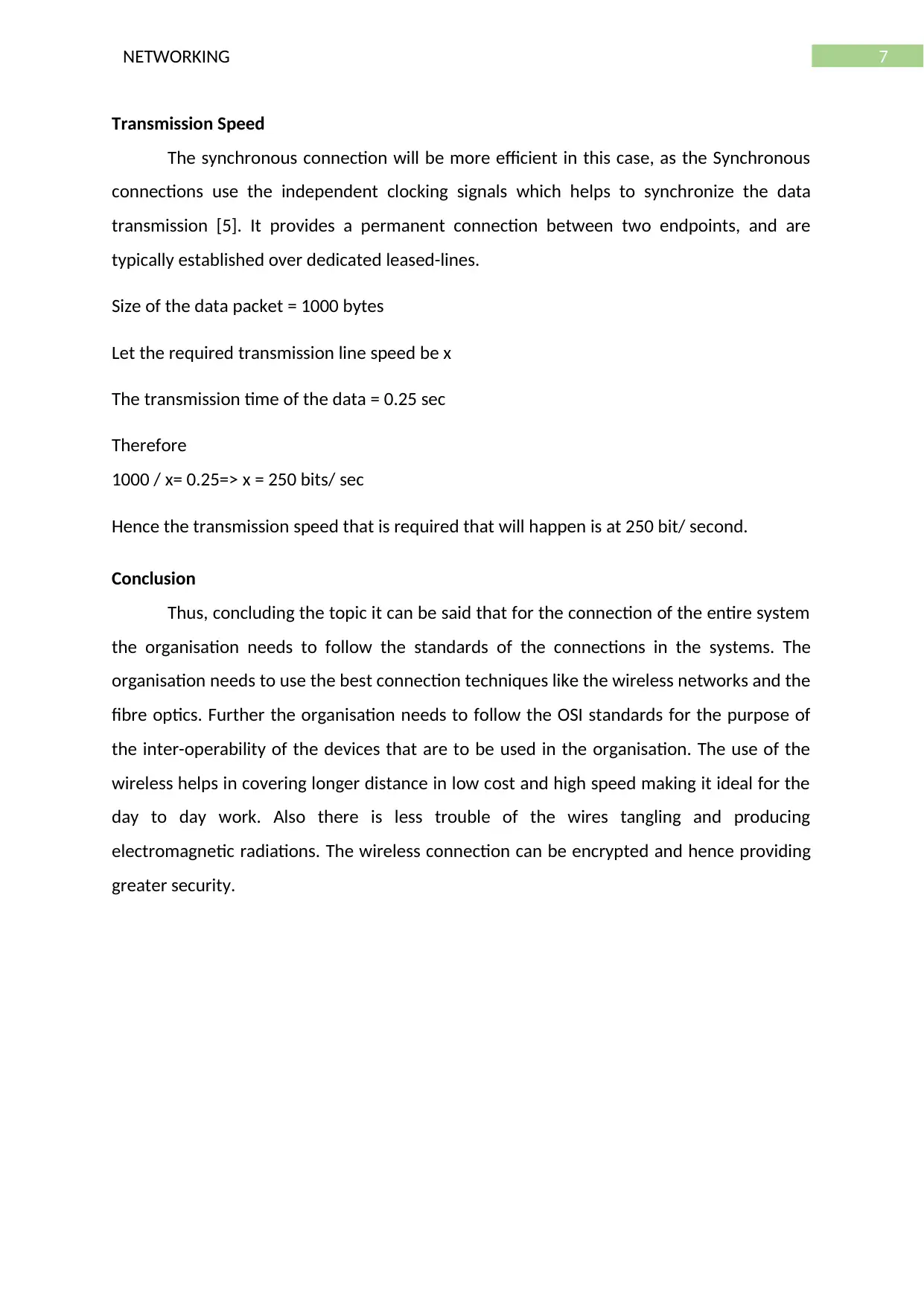
7NETWORKING
Transmission Speed
The synchronous connection will be more efficient in this case, as the Synchronous
connections use the independent clocking signals which helps to synchronize the data
transmission [5]. It provides a permanent connection between two endpoints, and are
typically established over dedicated leased-lines.
Size of the data packet = 1000 bytes
Let the required transmission line speed be x
The transmission time of the data = 0.25 sec
Therefore
1000 / x= 0.25=> x = 250 bits/ sec
Hence the transmission speed that is required that will happen is at 250 bit/ second.
Conclusion
Thus, concluding the topic it can be said that for the connection of the entire system
the organisation needs to follow the standards of the connections in the systems. The
organisation needs to use the best connection techniques like the wireless networks and the
fibre optics. Further the organisation needs to follow the OSI standards for the purpose of
the inter-operability of the devices that are to be used in the organisation. The use of the
wireless helps in covering longer distance in low cost and high speed making it ideal for the
day to day work. Also there is less trouble of the wires tangling and producing
electromagnetic radiations. The wireless connection can be encrypted and hence providing
greater security.
Transmission Speed
The synchronous connection will be more efficient in this case, as the Synchronous
connections use the independent clocking signals which helps to synchronize the data
transmission [5]. It provides a permanent connection between two endpoints, and are
typically established over dedicated leased-lines.
Size of the data packet = 1000 bytes
Let the required transmission line speed be x
The transmission time of the data = 0.25 sec
Therefore
1000 / x= 0.25=> x = 250 bits/ sec
Hence the transmission speed that is required that will happen is at 250 bit/ second.
Conclusion
Thus, concluding the topic it can be said that for the connection of the entire system
the organisation needs to follow the standards of the connections in the systems. The
organisation needs to use the best connection techniques like the wireless networks and the
fibre optics. Further the organisation needs to follow the OSI standards for the purpose of
the inter-operability of the devices that are to be used in the organisation. The use of the
wireless helps in covering longer distance in low cost and high speed making it ideal for the
day to day work. Also there is less trouble of the wires tangling and producing
electromagnetic radiations. The wireless connection can be encrypted and hence providing
greater security.
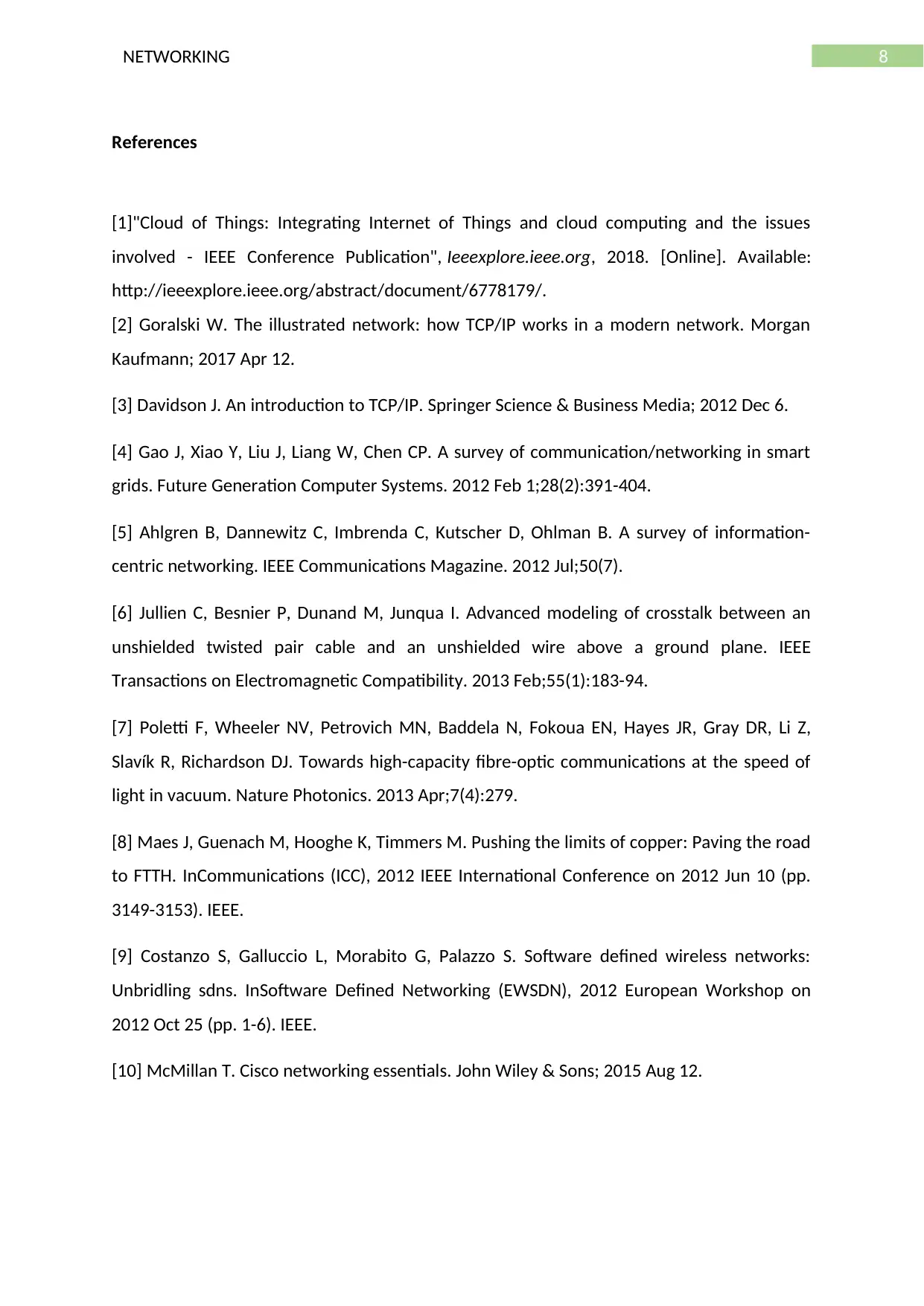
8NETWORKING
References
[1]"Cloud of Things: Integrating Internet of Things and cloud computing and the issues
involved - IEEE Conference Publication", Ieeexplore.ieee.org, 2018. [Online]. Available:
http://ieeexplore.ieee.org/abstract/document/6778179/.
[2] Goralski W. The illustrated network: how TCP/IP works in a modern network. Morgan
Kaufmann; 2017 Apr 12.
[3] Davidson J. An introduction to TCP/IP. Springer Science & Business Media; 2012 Dec 6.
[4] Gao J, Xiao Y, Liu J, Liang W, Chen CP. A survey of communication/networking in smart
grids. Future Generation Computer Systems. 2012 Feb 1;28(2):391-404.
[5] Ahlgren B, Dannewitz C, Imbrenda C, Kutscher D, Ohlman B. A survey of information-
centric networking. IEEE Communications Magazine. 2012 Jul;50(7).
[6] Jullien C, Besnier P, Dunand M, Junqua I. Advanced modeling of crosstalk between an
unshielded twisted pair cable and an unshielded wire above a ground plane. IEEE
Transactions on Electromagnetic Compatibility. 2013 Feb;55(1):183-94.
[7] Poletti F, Wheeler NV, Petrovich MN, Baddela N, Fokoua EN, Hayes JR, Gray DR, Li Z,
Slavík R, Richardson DJ. Towards high-capacity fibre-optic communications at the speed of
light in vacuum. Nature Photonics. 2013 Apr;7(4):279.
[8] Maes J, Guenach M, Hooghe K, Timmers M. Pushing the limits of copper: Paving the road
to FTTH. InCommunications (ICC), 2012 IEEE International Conference on 2012 Jun 10 (pp.
3149-3153). IEEE.
[9] Costanzo S, Galluccio L, Morabito G, Palazzo S. Software defined wireless networks:
Unbridling sdns. InSoftware Defined Networking (EWSDN), 2012 European Workshop on
2012 Oct 25 (pp. 1-6). IEEE.
[10] McMillan T. Cisco networking essentials. John Wiley & Sons; 2015 Aug 12.
References
[1]"Cloud of Things: Integrating Internet of Things and cloud computing and the issues
involved - IEEE Conference Publication", Ieeexplore.ieee.org, 2018. [Online]. Available:
http://ieeexplore.ieee.org/abstract/document/6778179/.
[2] Goralski W. The illustrated network: how TCP/IP works in a modern network. Morgan
Kaufmann; 2017 Apr 12.
[3] Davidson J. An introduction to TCP/IP. Springer Science & Business Media; 2012 Dec 6.
[4] Gao J, Xiao Y, Liu J, Liang W, Chen CP. A survey of communication/networking in smart
grids. Future Generation Computer Systems. 2012 Feb 1;28(2):391-404.
[5] Ahlgren B, Dannewitz C, Imbrenda C, Kutscher D, Ohlman B. A survey of information-
centric networking. IEEE Communications Magazine. 2012 Jul;50(7).
[6] Jullien C, Besnier P, Dunand M, Junqua I. Advanced modeling of crosstalk between an
unshielded twisted pair cable and an unshielded wire above a ground plane. IEEE
Transactions on Electromagnetic Compatibility. 2013 Feb;55(1):183-94.
[7] Poletti F, Wheeler NV, Petrovich MN, Baddela N, Fokoua EN, Hayes JR, Gray DR, Li Z,
Slavík R, Richardson DJ. Towards high-capacity fibre-optic communications at the speed of
light in vacuum. Nature Photonics. 2013 Apr;7(4):279.
[8] Maes J, Guenach M, Hooghe K, Timmers M. Pushing the limits of copper: Paving the road
to FTTH. InCommunications (ICC), 2012 IEEE International Conference on 2012 Jun 10 (pp.
3149-3153). IEEE.
[9] Costanzo S, Galluccio L, Morabito G, Palazzo S. Software defined wireless networks:
Unbridling sdns. InSoftware Defined Networking (EWSDN), 2012 European Workshop on
2012 Oct 25 (pp. 1-6). IEEE.
[10] McMillan T. Cisco networking essentials. John Wiley & Sons; 2015 Aug 12.
⊘ This is a preview!⊘
Do you want full access?
Subscribe today to unlock all pages.

Trusted by 1+ million students worldwide
1 out of 9
Related Documents
Your All-in-One AI-Powered Toolkit for Academic Success.
+13062052269
info@desklib.com
Available 24*7 on WhatsApp / Email
![[object Object]](/_next/static/media/star-bottom.7253800d.svg)
Unlock your academic potential
Copyright © 2020–2025 A2Z Services. All Rights Reserved. Developed and managed by ZUCOL.




